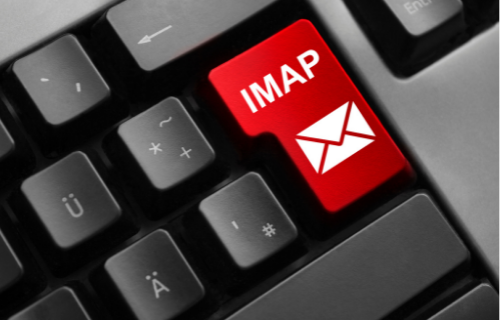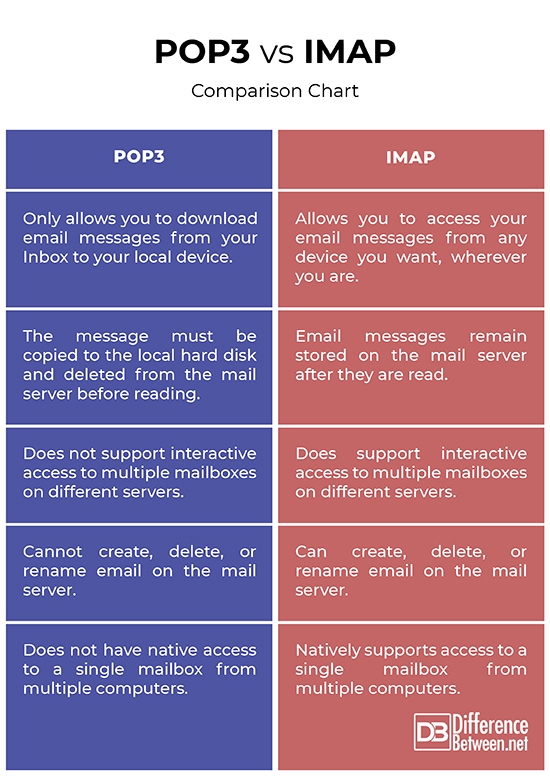Difference Between POP3 and IMAP
POP and IMAP are the two most common methods used to access mail from a third-party email client. Both are message accessing agents (MAA) or you could say, protocols, used to retrieve messages from the mail server to the receiver systems. Although each method downloads email data from AOL to your device, they are not the same. We look at some key differences between the two to help you choose the right one for your needs.

What is POP3?
Post Office Protocol (POP) is the most common and widely used message request protocol for transferring messages from an email server to an email client. Since the first version was created in 1984, the POP (currently at version 3) has been the Internet standard protocol used by virtually ever email client till date. The POP Version 3 (or POP3) is the version in common use today for the retrieval of email messages. POP3 enables a client to retrieve mail from a remote server mailbox. It is the protocol used both to store the mail on the server and download their mail to their computer. However, POP3 is only a retrieval protocol and it cannot be used to send mail. Simple Mail Transfer Protocol (SMTP) is still used to transfer mail between mailboxes.

What is IMAP?
The Internet Message Access Protocol (IMAP), like POP is a method used by email clients to retrieve email messages from a mail server over a TCP/IP connection. It stores email messages on a mail server and enables the recipient to view and manipulate them as if they were stored locally on their devices. IMAP4 is the current version and the one widely used today. It is an application layer protocol for accessing email messages from a mail server. IMAP was designed by Mark Crispin in 1985 as a remote access mailbox protocol. It’s one of the most commonly used protocols for retrieving emails today. It allows you to store messages on a server and divide them into different folders, so you can access your mailbox from any computer.
Different between POP3 and IMAP
Protocol
POP3 is a simple message request protocol used to transfer messages from an email server to an email client. It only allows you to download email messages from your Inbox to your local device. IMAP is a more advanced message access protocol that stores email messages on a mail server and enables the recipient to view and manipulate them as if they were stored locally on their devices. It allows you to access your email messages from any device you want, wherever you are.
Storage/Access
Before you can read an email message with POP3, the message must be copied to the local hard disk and deleted from the mail server. With IMAP, email messages remain stored on the mail server after they are read. When you read email messages using IMAP, you read it from the email service rather than download or store it on your local computer. This allows you to access your email from any device you want, wherever you are. In POP3, the emails can only be accessed from a single device at a time.
Multiple Mailboxes Support
One of the most demanding features of IMAP is the ability to store multiple mailboxes on the server. By allowing users to have multiple mailboxes on the server, IMAP allows them to access their archived mail from any device they want, regardless of their location. POP3, on the other hand, does not support interactive access to multiple mailboxes on different servers.
Manipulation
IMAP is both an offline (like POP3) and online protocol, which enables you to manipulate your mailbox that resides on your email server as if it were stored locally on your computer. Instead of downloading and deleting them, you can manipulate your messages, which makes sure they remain on the IMAP server. With POP3, you cannot create, delete, or rename email on the mail server.
POP3 vs. IMAP: Comparison Chart

Summary
Both POP and IMAP are standard mail access protocols. However, because of the rich feature set of the IMAP protocol, they are more different than they are alike. That being said, POP is an excellent solution for communities of users that always access mails from a single computer. For users who want to access mail from more than one computer, they have to keep separate and duplicate mail archives on every machine from which they read their email. IMAP, on the other hand, is a more advanced message access protocol that can be accessed from any remote platform with IMAP software.
Which is better IMAP or POP3?
POP3 is better if you are going to access your mail from a single computer. But, if you want to access your mail from more than one computer, IMAP is the ideal solution. In addition, IMAP is a more advanced message access protocol that can be accessed from any remote platform with IMAP software, unlike POP.
Is Gmail a POP or IMAP?
Gmail mainly runs on the IMAP system, but it also offers POP mail server access. The only difference is that IMAP can be used across multiple devices whereas POP can only be used on a single computer at a time.
- Difference Between Caucus and Primary - June 18, 2024
- Difference Between PPO and POS - May 30, 2024
- Difference Between RFID and NFC - May 28, 2024
Search DifferenceBetween.net :
Leave a Response
References :
[0]Zurawski, Richard. The Industrial Information Technology Handbook. Florida, United States: CRC Press, 2018. Print
[1]Komar, Brian. Sams Teach Yourself TCP/IP Networking in 21 Days. Indiana United States: Sams Publishing, 2002. Print
[2]FitzGerald, Jerry and Alan Dennis. Business Data Communications and Networking. New Jersey, United States: John Wiley & Sons, 2009. Print
[3]Mullet, Dianna and Kevin Mullet. Managing IMAP. California, United States: O'Reilly Media, 2000. Print
